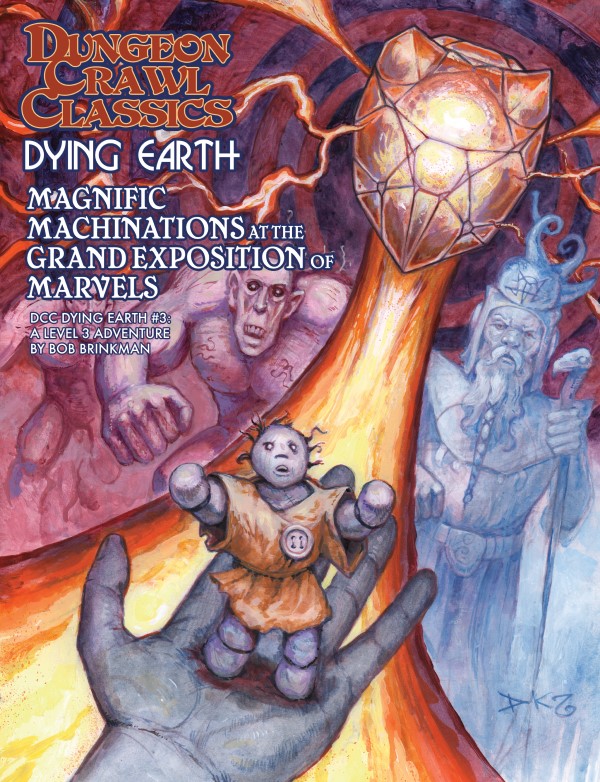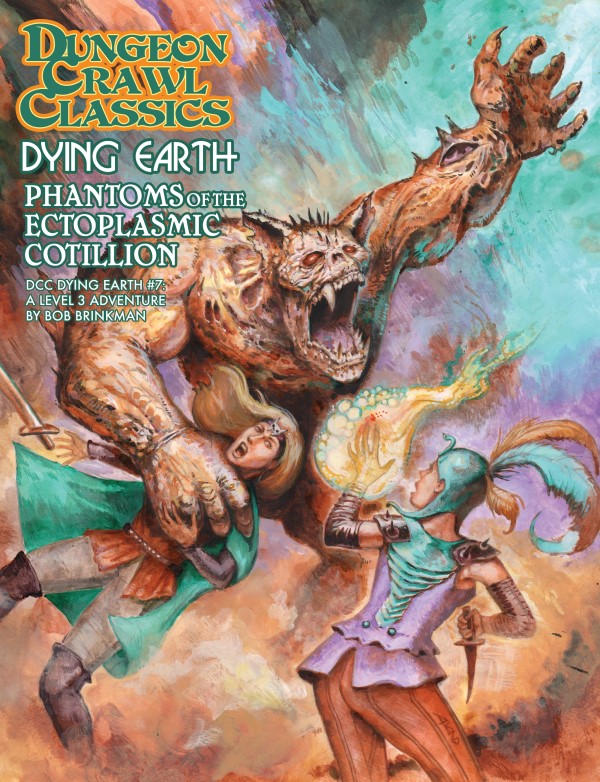
Welcome to the wondrous far-future world of DCC Dying Earth! The DCC Dying Earth Setting is an all-new gaming universe for Dungeon Crawl Classics, inspired by the classic sword-and-sorcery works of Jack Vance. To celebrate the release of DCC Dying Earth, we are showcasing a series of articles that looks at the many unique classes, spells, equipment, mechanics, and themes that go into making DCC Dying Earth a completely new experience!
The DCC DE Witch: A Demon-Summoning Vitality-Transferring Master of Ensqualmation!
By Terry Olson
Witches are masters of dark magic, rituals, and maledictions. Unlike wizards, who attempt to tame unpredictable and wild magic, or clerics, whose faith grants them a divine power, witches draw strength from dead gods and the cruel and strange entities of the underworld and demon-lands, often trading their very vitality for the dark gifts they grant. – DCC Dying Earth Player’s Libram
The witch is a class unlike any you’ve encountered in DCC. They are specialists with curses and squalms. They can absorb the vitality from one creature, hold onto it, and then transfer it to another. They have a unique blend of arcane and divine spells that derives from a pact made with a sub-world or overworld entity, which affects the potency of their casting. In fact, they frequently make pacts and associations with all manner of the Dying Earth’s demons, frits, and winged glowing-eyed creatures, either as servants or companions.
Curses and Squalms
“Lehuster, be good enough to instruct us as to the signs by which ensqualmation may be recognized?” “Gladly. In the final stages the evidence is obvious: the victim becomes a woman. An early mannerism is the habit of darting the tongue rapidly in and out of the mouth. Have you not noticed this signal among your comrades?” “Only in Zanzel himself, but he is one of our most reputable associates. The concept is unthinkable.” “When one deals with the Murthe, the unthinkable becomes the ordinary, and Zanzel’s repute carries no more weight than last year’s mouse-dropping if that much.” – Rhialto the Marvelous
A first-level witch begins play with the level 2 divine spell curse (as ensqualm). A DCC cleric would typically have to wait until level 3 to gain this spell. In addition to DCC curses, the witch employs squalms, which are particular curses that that the witch can dismiss when willing. Removing oneself of a squalm by alternative means is much harder, requiring fulfilling some specific tasks or slaying the witch (but sometimes that doesn’t even work).
Writing curses was a blast for the writing team; we all enjoyed it after writing many spells and monsters. Somehow, envisioning various means of ensqualmation allowed us to flex our gray matter a bit differently. Of course, we included the gender-changing Curse of Ensqualmation inspired by the above excerpt, but we extended squalms far beyond the realms of gender. Here’s an example.
Curse of Misfortunate Amelioration
(Moderate Curse)
Before the War of the Wizards and Witches, the Eleventh Epoch of the Seventeenth Aeon begot multifarious curses and spells, one progeny being the curse of misfortunate amelioration. Originally invoked by a vengeful witch against those seeking services from priests and magicians, the imprecation is used by those wishing vengeance for an offense (obloquy, libidinous advances, attempts to impose moribundity, etc.). The malediction is invoked by holding few drops of the victim’s blood and saying the following into the sanguine sample:
Ungrateful cur who scorns my aid,
Instead seek healing touch divined.
Ethodea’s bounty a debt unpaid,
Salubrity found but fortune missed,
Until yourself in ground you’ve laid,
Thrice snake entwined and poison kissed.
The curse carries no immediately perceivable penalty. However, whenever the victim is invigorated with healing effectuated by anyone other than the invoker, the salubrious unfortunate loses 1 point of Luck. This loss cannot be regained as part of any class’s normal rules for Luck recovery, including thieves, wayfarers, and halflings. The curse is insidious and can ruin the life of its victim before one realizes they are cursed. A witch can make an Intelligence check modified by her level to recognize the symptoms (DC 12 to realize the victim is cursed, DC 18 to recognize the specific curse, and DC 20 to identify the originator).
The curse can only be remedied by the victim lying in the ground (a hole, minor excavation, grave, etc.), accompanied by three venomous snakes. When one of the vipers successfully poisons the victim via a failed save, the curse is lifted and lost Luck restored. Slaying the malediction’s originator does not dispel the imprecation’s effects.
You shouldn’t have suffered this particular squalm from simply reading it, but if you did, you know what to do!
Speaking of Gender
Some players have preconceived notions that a witch must be female, but this is not the case. Vance includes male witches, such as Prince Datul Omaet of Cansaspara. Play whatever gender you want! With that being said, the story of The Murthe in Rhialto the Marvelous has a concept ripe for role play. In this story, by the Twenty-First Aeon (present day in DCC Dying Earth) the power of women has waned, so The Murthe, a sorceress of staggering potency, ensqualms male magicians to become female witches. Roleplaying a formerly-male-magician female witch whose agenda is to convert men of power to women could be a whole lot of fun!
Transferring Vitality
Rather than laying on hands like a cleric, where healing is granted by divine power, the witch invokes her pact to take the lifeforce of one being and give it to another. The witch makes a spell check and if successful, vitality is transferred, usually at the cost of 1 point of the donor’s Strength, Agility, or Stamina per hit dice transferred. If the donor is unwilling, they get a save vs. the spell check. In playtests, the witches almost always targeted unwilling donors for transferring vitality. It’s also worth mentioning that the witch can store the vitality for later transfer, as long as she can maintain concentration (as defined in the DCC rulebook) and can move at half speed.
Pacts and Demons
At level 1, the witch makes a pact with an overworld or sub-world entity. It could be Blikdak, Ruler-Divinity of the demon-world Jeldred, or Paphnis, Goddess of Beauty and Gynodyne
of the Century, or even The Murthe. This pact enables him to choose one spell sympathetic with his pact to be cast at +1d to spell checks, but he must then choose a different spell to be cast at -1d. He may choose an additional pair with each gained level. For example, a level 1 witch that has a pact with Blickdak could choose to enhance the spell check for chill touch, darkness, demon summoning, paralysis, resist cold or heat, or the spell of macroid castigation. For the sake of clarity, the witch has more possible spells than these (and note that they are a mix of arcane and divine), but these are the ones sympathetic to sub-world entities like Blickdak.
Some of you may be asking me, “Demon summoning at level 1? Is that a typo? That’s a level 3 wizard spell in DCC!” It’s not a typo, dear Reader. Witches generally get this spell earlier than DCC wizards because they are more familiar with demonic interactions. The spell is still a level 3 spell (requiring at least a 16 spell check for success), but witches access it early, and those with sub-world pacts might even cast it with a d24… at level 1!
Whether you’re a silk-clad prince seeking hidden power, a dark-eyed summoner of demons, or a formerly-male-magician bent on pangynic dominance, the witch is a fantastic class to play with plenty of magical options to apply to any situation. For those who are cleric-averse but would like to have some of the cleric’s mechanics, the witch is a great alternative. Most importantly, who doesn’t enjoy bestowing curses?










